
A locomotive or engine is a rail transport vehicle that provides the motive power for a train. If a locomotive is capable of carrying a payload, it is usually rather referred to as a multiple unit, motor coach, railcar or power car; the use of these self-propelled vehicles is increasingly common for passenger trains, but rare for freight trains.

An electric locomotive is a locomotive powered by electricity from overhead lines, a third rail or on-board energy storage such as a battery or a supercapacitor. Locomotives with on-board fuelled prime movers, such as diesel engines or gas turbines, are classed as diesel–electric or gas turbine–electric and not as electric locomotives, because the electric generator/motor combination serves only as a power transmission system.

The British Railways Class D3/7 is a class of 0-6-0 diesel electric shunting locomotives built as LMS Nos. 7080–7119. The class were built from May 1939 through to July 1942 by the London, Midland and Scottish Railway at their Derby Works using a diesel electric transmission supplied by English Electric.

In rail transport, head-end power (HEP), also known as electric train supply (ETS), is the electrical power distribution system on a passenger train. The power source, usually a locomotive at the front or 'head' of a train, provides the electricity used for heating, lighting, electrical and other 'hotel' needs. The maritime equivalent is hotel electric power. A successful attempt by the London, Brighton and South Coast Railway in October 1881 to light the passenger cars on the London to Brighton route heralded the beginning of using electricity to light trains in the world.

Class EE1 was an electric locomotive commissioned by the North Eastern Railway in 1922. Ownership passed to the London and North Eastern Railway in 1923 and to British Railways in 1948.

The E.464 is a class of Italian railways electric locomotives. They were introduced in the course of the 1990s for hauling light trains, especially for commuter service. They were acquired by FS Trenitalia to replace the old E.424 and E.646, dating from the 1940s and 1950s. The class was originally designed by ABB Trazione, later ADTranz, and produced in the Italian plant of Vado Ligure.

The FS E.625 and E.626 are two classes of Italian electric locomotives produced for the Ferrovie dello Stato. They were introduced in the course of the 1920s and remained in service until the 1990s. The E.626 was the first locomotive fed by 3,000 V DC overhead line in Italy.

Line 2 is an 18.9-kilometre (11.7 mi) rapid transit line, part of the Naples Metro in Naples, Italy. As of January 2024, Line 2 connects 12 stations. It is operated by Trenitalia.
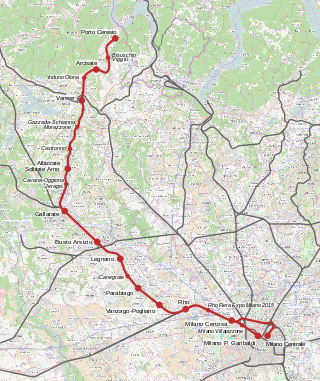
Porto Ceresio–Milan railway is a railway line in Lombardy, Italy. It uses the tracks of the Milan–Arona railway until Gallarate.
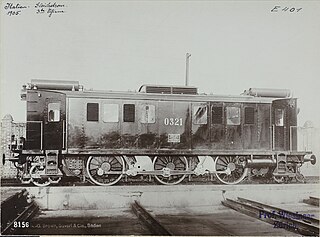
The FS Class E.320 was a class of Italian third rail electric locomotive built between 1915 and 1918. Five units were built and they saw service on the Varese - Milan - Porto Ceresio line. They were powered by two direct current electric motors, designed by Tecnomasio Italiano-Brown-Boveri (TIBB), giving a maximum speed of 95 km/h (59 mph). The final assembly and the mechanical design were by Officine Meccaniche (OM). At the time of their construction they were the most powerful direct current locomotives in the world. The transmission of the motion to the three axles was by connecting rods and these were subject to frequent breakages.

The FS Class E.430 locomotives, initially classed as RA 34, were three-phase alternating current electric locomotives of the Italian railways. They were built for Ferrovia della Valtellina by Ganz and MÁVAG in 1901 and had a power output of 440 kW and a haulage capacity of 300 tons. One locomotive is preserved.

FS Class E.331 was a class of three-phase electric locomotives of the Italian State Railways. Eighteen of these 2′C2′ locomotives were built between 1914 and 1919 by Breda and Brown-Boveri.

FS Class E.333 was a class of electric locomotives of the Ferrovie dello Stato (FS), powered by three-phase alternating current, which were in service from 1923 to 1968. They were designed by Kálmán Kandó for hauling fast passenger trains. Having the same electrical equipment as the FS Class E.552 locomotives, they presented the same defects and had to be modified. After modification, they were able to carry out the services for which they were designed.

FS Class E.321 was a class of 17 third-rail electric locomotives, built for the Italian State Railways (FS) for operation on the Varese line and on the underground line in Naples.
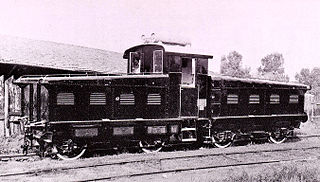
The FS Class E.421 locomotive of the Italian State Railways (FS) was a battery electric locomotive, built as a single unit (E.421.1) and used for shunting at the old Milano Centrale railway station. It was the only battery electric locomotive to be registered in the FS fleet.
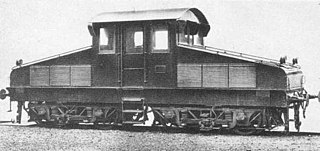
FS class E.420 locomotive was a third rail electric locomotive built for the operation of the Milan - Gallarate - Varese railway in Italy.
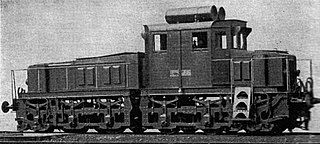
The FS Class E.620 was a class of third-rail electric locomotives built by Officine Meccaniche Reggiane for the Italian State Railways (FS). They were built in 1925 using motors and electrical equipment from Class E.10 railcars which had been withdrawn in 1923. After World War II they were converted to 3,000 volt DC operation and became FS Class E.621.
The FS Class E.621 was a class of five electric locomotives of the Italian State Railways (FS). They were rebuilt in 1947 from FS Class E.620, which was originally built in 1925. The main change was conversion from 650 V DC third rail to 3,000 V DC overhead line power supply.

FS Class 400 were steam locomotives of French construction, built for service in Italy. They were 0-8-0 tender locomotives with two outside cylinders.

The E.323 locomotives and E.324 motor trailers were two sets of 3000 V direct current electric locomotives of the Italian State Railways (FS) used for shunting service in large rail yards and in embarking and disembarking from ferries.



















